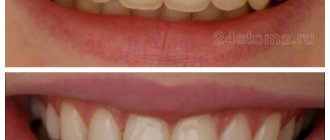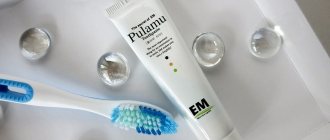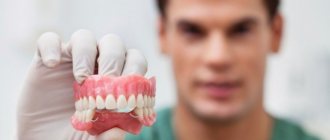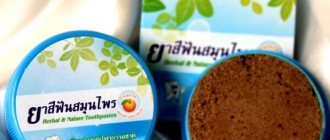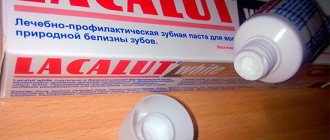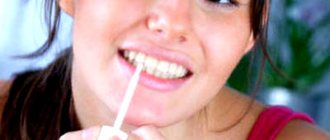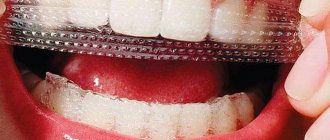3255
Several decades ago, the main means of dental hygiene was not toothpaste, but tooth powder. Having a coarse abrasive as its main component, this product often did more harm than good.
How does the modern version differ from its predecessors?
What is tooth powder
A hygienic product for the oral cavity, which consists of 98-99% of chemically deposited chalk (other bases are less commonly used). The rest consists of various additives, corrective properties and additional characteristics of the powder for teeth.
The ancient Romans used crushed bones, egg shells, shells and shells of sea creatures to make it. Their substance was used as a means for pain relief and teeth whitening.
The development of dental care continued relatively uneventfully until 1000 AD, when the Persians warned others of the dangers of using overly abrasive powders that could damage teeth. They proposed creating the powder using softer materials such as burnt snail shells, dried animal parts, herbs and honey.
The founder of the modern product originated in Great Britain at the end of the 18th century. Tooth powder was first introduced to the market in the UK.
These powders may have been developed by doctors, dentists and chemists, but they also included some quite abrasive substances: brick dust, ground porcelain, pottery and cuttlefish. Bicarbonate of soda, commonly known as baking soda, was often a key ingredient. By the end of the century, borax was added for cleansing and foaming purposes.
Is it possible to brush children's teeth?
Tooth powder is an environmentally friendly and effective product, but it is too aggressive for the thin enamel of children’s teeth.
The use of calcium carbonate based powders is strongly discouraged for children .
You can use powders based on dried and crushed medicinal herbs - their abrasive effect on the enamel is much less, and they will not harm the teeth.
Thai and Indian plant-based tooth powders are also distinguished by their mild and gentle effect on teeth - they can be used by both children and adults with dental hypersensitivity.
Different kinds
Oral hygiene is carried out in accordance with the age of the person and the condition of his oral cavity.
This is how they distinguish:
- Adult and children's powder formulations;
- Therapeutic and preventive;
- Whitening.
The children's product contains precipitated chalk of the finest fraction, additives are minimized and the vast majority are plant-based.
If after the cleansing procedure there are unpleasant sensations, pain, or discomfort, you should visit a doctor. Perhaps these are signs of incipient caries or periodontitis, which are easier to treat at the initial stage.
There are many types of dry cleaning compositions on sale, which differ in the following parameters:
- Aromatic and flavoring additives (cinnamon, ginger, nutmeg, mint).
- Additional natural ingredients (chalk, white clay, herbal extracts).
The choice of product depends on the age of the consumer, purpose of use and preference regarding aroma. Description of proven products that are in demand:
- Family . Does not contain toxic or carcinogenic compounds. Highly effective in removing soft plaque and formed dental deposits from the enamel surface.
- Whitening . A product with a whitening effect without dyes or fragrances.
- Mint . Thanks to the components of the powder, it has an antibacterial and anti-inflammatory effect, cleans and strengthens teeth well.
- Children's . The composition includes useful minerals, essential oils and extracts of medicinal plants that heal teeth and gums. Gently and effectively cleanses the enamel of baby and permanent teeth.
Compound
The main component is chalk.
Mint, menthol, ginger, and essential oils are used as flavoring agents.
To strengthen the gums, remove plaque and tartar, add white clay (colloidal kaolin), ground herbs, and sometimes spices (black pepper, turmeric and others).
Baking soda was considered a popular tooth powder due to its cleaning and whitening abilities, not to mention its low cost. However, modern dentists warn that it is too abrasive for daily use.
However, to make teeth whiter, baking soda is added to the cleaner. Tooth powders may also include agents used to bind, add color, or prevent hardening.
Which is better: tooth powder or toothpaste?
Although there have been many studies showing the importance of brushing teeth with fluoride toothpaste, few compare the benefits of toothpaste and tooth powder.
However, studies were conducted by the same doctor of science in dentistry in 2014 and 2022. Through experiments, the doctor found that tooth powder was more effective than toothpaste in removing surface stains from teeth and also in combating gingivitis caused by plaque.
Modern toothpastes and toothpowders contain many of the same ingredients, with the exception of fluoride. If sanitizing the oral cavity, strengthening the protective properties of enamel, and preventing caries is important to you, be sure to check the label of any product you buy to make sure it contains fluoride.
Tooth powders do not contain ingredients that remove intrinsic stains. Just like many toothpastes. Intrinsic stains are stains that occur inside the tooth rather than on its surface.
The most common causes of intrinsic stains are certain medications, using too much fluoride, and tooth decay. Tobacco and certain drinks such as coffee, tea and red wine can cause external stains.
Recommendations for use
It is important to carry out personal hygiene using a powder product, following certain principles. Among them:
- alternation of funds;
- high-quality rinsing;
- proper brushing of teeth and tongue.
Detailed instructions for use
Packages of dental powders usually have mini instructions on how to use them. But there are also a number of rules and tips for cleaning itself, which the dentist tells:
- Apply a little powder to a damp brush (it is advisable to use a dispenser and do not dip the brush into the jar).
- Carry out the first stage of cleaning the surface of the teeth.
Make only vertical movements (they better clean hard-to-reach places and do not cause harm). Do not press on the brush, but make gentle movements. Record the procedure time – at least 3 minutes. Don't forget to clean your tongue and cheeks. - If necessary, repeat the cleaning step a second time or add a portion of the product (not recommended for hypersensitivity).
- Rinse your mouth and brush thoroughly to prevent bacteria from growing on it.
And in the next video we’ll learn more ways to help whiten your teeth:
Storage rules
The package of tooth powder should be stored tightly closed in a dark and cool place, away from direct sunlight. Favorable temperature conditions for long-term storage from 0 to +25 degrees.
Packaging usually has a shelf life of 12 months to 2 years, depending on the manufacturer and composition. The main thing is to monitor the humidity in the room and prevent water from getting inside the jar with the product.
When using, it is important to place the open jar on a stable surface away from water or close the lid immediately to avoid falling and splashing.
Frequency of use
Dentists recommend alternating regular toothpastes with whitening ones , and using a combination of powders, rinses and cleaning threads. The optimal frequency of using tooth powder is two days a week.
Lovers of coffee, strong tea and cigarettes can brush their teeth more often. Preventive treatment courses lasting a week can be carried out.
With regular use of the powder, the tone will lighten gradually. To achieve a quick whitening effect, you can make application masks on your teeth using cotton pads, applying a paste of powder to them.
Keep this mask in your mouth for 15 minutes. This method has a good strengthening effect.
Teeth whitening powder: benefit or harm
The benefits and harms of a cleaning product depend on many factors. If whitening tooth powder is used correctly, it will only bring positive effects.
The permissible frequency of its use is once every three days. On other days, brushing is carried out as usual - with toothpaste twice a day.
Useful video
From this video you will learn about the beneficial properties of tooth powder:
If you want to quickly and safely whiten your smile, then pay attention to tooth powders. The advantage over toothpastes is obvious .
But before you start using tooth powder, consult your dentist, who will help you choose the best product for your enamel.
And remember that daily long-term use of dry products is harmful, so alternate with your usual neutral toothpastes. Take care of yourself and your teeth.
Pros and cons of using
Tooth powder copes well with the formation of plaque and prevents it from hardening and turning into tartar. Favors the development of good microflora.
But at the same time, frequent use can serve to destroy the enamel and, consequently, aggravate unpleasant sensations: sensitivity to cold and hot, pain, as well as the development of caries and inflammatory processes.
pros
The advantages of tooth powder also include:
- natural ingredients;
- high-quality plaque removal;
- softening of tartar;
- whitening properties;
- polishing;
- elimination of unpleasant odor;
- prevention and treatment of gingivitis and periodontitis;
- providing minerals and vitamins to oral tissues;
- ensuring normal ph;
- pathogen control;
- economical consumption;
- long shelf life;
- budget price.
There is information that the powder can be harmful if used continuously. Indeed, if you use only powder with coarse abrasives several times a day for several months, there is a possibility of damage to the enamel. Therefore, it is enough to use the powder 1-2 times a day and alternate it with pastes.
If the powder in the composition does not contain coarse particles, then it can be used without fear.
Minuses
Are there any disadvantages to tooth powder? Yes, of course there is, like any medicine and even a neutral product.
Flaws:
- if sensitivity is increased, the powder can enhance it, so it is important to choose the right composition;
- abrasive particles can damage thin enamel and contribute to sensitivity;
- regular packaging is not convenient; when used, the powder may get wet, and a loose lid will not preserve the powder if the jar falls;
- treatment for a number of oral diseases is impossible without additional components or the participation of a dentist;
- When treating teeth with powder, it is important to follow the direction of movement, clean correctly and not violate the technology.
If industrial formulations cannot lead to the expected result, you can create the powder yourself or order it from those who manufacture it using an individual recipe and technology.
Most popular manufacturers
Phytocosmetic
The main advantages of this tool include:
- simplicity of composition and naturalness of its ingredients ;
- visual cleaning effectiveness, which is obvious after the first use ;
- whitening and polishing effect;
- therapeutic effect (reduces bleeding gums);
- pleasant taste.
The main disadvantage is the high abrasiveness of the crystals (overuse of the product can damage the enamel).
Tooth powder “Phytocosmetic Whitening” can be purchased at a price of no more than 27 rubles per 75 grams.
Biobeauty
Main advantages:
- has a strong whitening effect due to the content of natural zeolite minerals that can “absorb” plaque;
- provides enamel with minerals;
- has a refreshing and disinfecting property , giving freshness to the breath;
- destroys pathogenic bacteria;
- Thanks to natural minerals and medicinal herbs, it normalizes the acid-base balance ;
- has a healing effect, protecting the gums from periodontal disease .
The downside is the high cost of the product (compared to Russian ones): the average price is at least 450 rubles per 70 grams.
BlanX Med
Main advantages:
- aimed at caring for sensitive gums , contains plant antioxidants, zinc citrate and sublimation of healing Irish moss;
- not only whitens, but also protects teeth from plaque formation ;
- saturated with vitamin E, which increases gum regeneration ;
- has a strong antibacterial effect ;
- absolutely harmless to healthy flora and does not irritate the mucous membrane ;
- effectively eliminates darkening of enamel and returns its natural whiteness;
- mineralizes tooth enamel;
- well with bleeding gums .
With the exception of the high price, no disadvantages have been identified.
Tooth powder "BlanX Med" can be purchased at prices ranging from 460 to 530 rubles per 75 grams.
Dentaem
Main advantages:
- contains many natural ingredients that have natural healing properties;
- gives freshness to breath , improves enamel health, increases immunity of the mucous membrane and the entire oral cavity;
- helps prevent caries ;
- has an excellent whitening effect ;
- Dentaem elements have strong bactericidal properties , kill E. coli, eliminate microbes and fungi;
- active components neutralize food residues and prevent the appearance of heavy odors;
- contains vitamins.
No disadvantages identified. The average price is 239 rubles for 60 grams.
Lemon MiKo “Whitening”
Main advantages:
- includes only natural substances ;
- cleans teeth perfectly ;
- has low abrasiveness;
- refreshes the oral cavity;
- actively fights bacteria ;
- saturates tooth enamel with vitamins , increases resistance to pathogens;
- Lemon extract returns natural whiteness to enamel and relieves inflammation .
The average price is 230 rubles per 50 grams.
Avanta "Family"
Main advantages:
- consists of very fine crystals, due to which it practically does not damage the enamel ;
- has a pleasant mint aroma and refreshing taste;
- gives natural freshness to breath ;
- perfectly cleans teeth ;
- , there is no pain during cleaning ;
- saturated with useful minerals .
The average price is about 30 rubles.
How to make tooth powder at home
There are dozens and even hundreds of recipes that are not difficult to find online for making your own tooth powder.
Luckily, instead of ash and eggshells, these mixtures are based on relatively easily obtained ingredients such as chalk, powdered sugar, baking soda, borax, charcoal, honey and peppermint oil, among other ingredients.
One of the universal recipes:
Base: White clay. To it are added: ground sea salt, ground dried tansy, mint, pine needle extract, 2-3 drops of tea tree essential oil. Each bulk ingredient is taken at a rate of 1:30, where one part of the substance is added to 30 parts of white clay.
